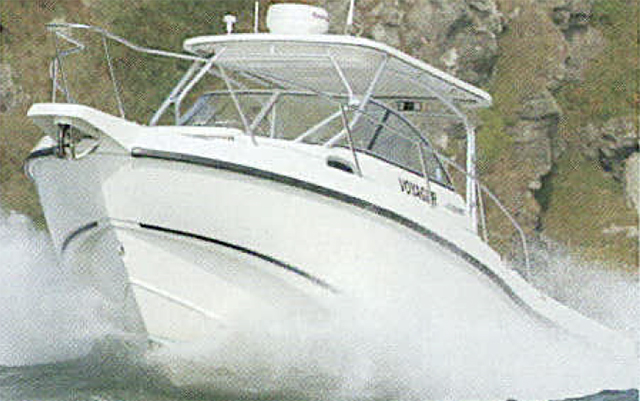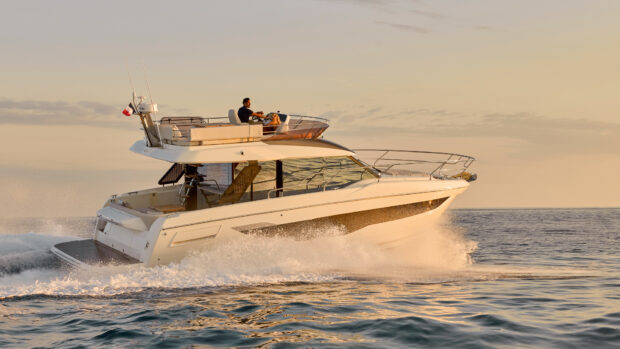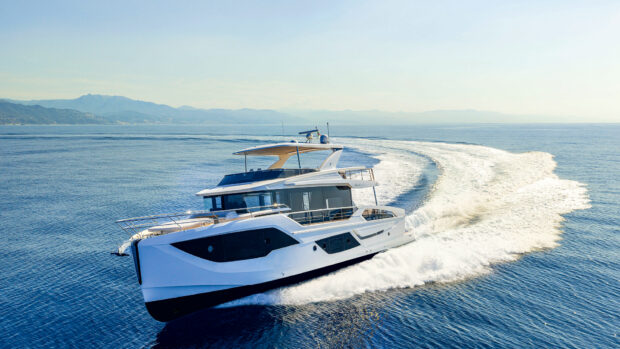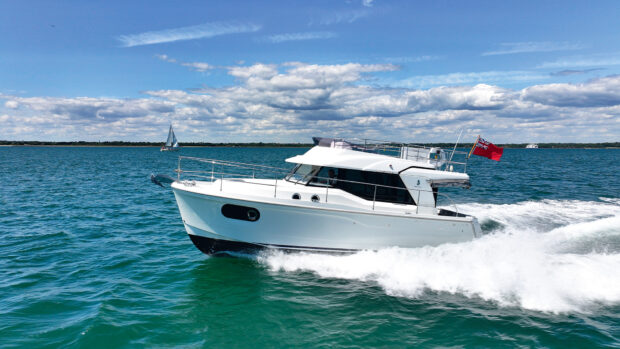Build quality and brand loyalty are not in doubt, but how much demand is there for an outboard-engined sports-fisher in the UK? John Wood takes a look at the Boston Whaler 255 Conquest...
American boatbuilders Boston Whaler are best known in this country for their range of unsinkable, walkaround ports-fisher craft. But, until now, their larger Conquest cuddy-cabin range haven’t made much impact on this side of the pond. The new Boston Whaler 255 Conquest aims to change all that.
Not only is it the smallest Boston Whaler co boast a proper cuddy, with an overall length of 26ft 11in, but its practical styling and optional hardtop make it ideally suited to British waters. So far, so good. The one fly in the ointment is that the Boston Whaler 255 Conquest is only available with outboard motors.
While this is fine for power-hungry, petrol-rich American buyers, UK boaters usually prefer sterndrive petrol or even diesel power for this size of boat.
That said the latest generation of direct-injection two and four-stroke outboard motors are so much cleaner and more economical than the inefficient two-strokes of old that they are rapidly regaining popularity.
Design and build of the Boston Whaler 255 Conquest
The benefits of a cuddy cabin on sports-fishing boats are obvious: shelter from the elements, the possibility of overnighting and the convenience of a toilet.
For designers, the problem is that decks offering easy access right round the boat, so important on this type of craft, impinge on the space available down below.
Still, a deep bow ensures that the Boston Whaler 255’s cuddy is comparatively generous. Nevertheless, it is the wide aft deck that is the key to the design. It gives you freedom to fish, or serves equally well for watersports.

The Boston Whaler 255 Conquest has a versatile cockpit with good all-round deck access and stowage.
There is little glitz in the presentation of the Boston Whaler 255 Conquest, but it is based on quality materials and workmanship. The fibreglass work is excellent, with plenty of one-piece mouldings for added strength and durability, and locker lids fit well.
The standard of fittings is first-rate, and there are plenty of them, including rod-holders, racks and in-deck fishboxes for anglers.
Whaler styling is purposeful. Their cuddy boats cannot replicate the sleek appearance of their open-deck craft, and inevitably have a heavier look.
Even so, the Boston Whaler 255 Conquest is surprisingly attractive, thanks to its clean lines and minimal embellishment.
Accommodation aboard the Boston Whaler 255 Conquest
The cabin layout keeps things simple. The forward vee-berths convert into a generous double with the table dropped down and infill cushions deployed.
Lifting the after starboard cushion reveals the toilet, and there is a small built-in washbasin with a cold water tap to port.
Open stowage, including rod-holders, is provided around the edges, and there are lined lockers under the side cushions.

A simple cuddy offers good headroom.
That’s just about it as far as fittings go, besides the optional stereo, with remote control at the helm. There is more than ample standing headroom near the entrance, and sitting headroom forward.
Good natural light comes in via a deck hatch and two portholes, and the door from the cockpit is generously wide. In keeping with Whaler design philosophy, the emphasis is on function rather than comfort. But the quality of the mouldings is first-class, as is the upholstery.
Exterior of the Boston Whaler 255 Conquest
The designers have done an excellent job of keeping the cockpit free of unnecessary clutter. There are no sunbeds or cockpit table (even on the options list), but there are two informal seats, behind the helm and passenger seats, and a folding aft bench.
As well as the engine access hatch, the cockpit sole has three inset fish boxes, with drains and gas strut-supported lids. There is a further draining locker in the base of the passenger seat, a coolbox under the helm seat and, of course, rod stowage.

The helmsman’s and co-pilot’s seats are adjustable for comfort, but offer little side support.
Few owners will need any more storage than this. The walkways forward to the bow are wide and there are handholds all the way, including stainless steel guardrails.
The solid bow locker is capacious and a substantial roller is on hand to aid anchor recovery. Boarding from the stern is easy, via a transom door from the split bathing platform.

Whaler pedigree comes at a price. Outboards might limit future value.
An extendable boarding ladder is mounted co starboard. At the helm, the driver gees a steel wheel as standard, on a tilt-adjuster, plus a footrest and well placed twin throttles.
His and his co-driver’s seat swivel and slide fore-and-aft to help them get comfortable, although we would prefer more side support.
The entire centre section of the dash is left empty for the owner to fit out with electronic navigation and fish-finding equipment.
And at first sight the three standard gauges in the top section look rather mean on a craft of this price.

Our test boat had the optional hardtop, likely to attractive to UK buyers.
However, these SmartCraft instruments perform a multi-functional role, covering full engine information as well as fuel and trip details.
It might rake you a while to find your preferred settings, but once set up you won’t be left wanting for information. If you opt for the hardtop, this gives yet more mounting positions for electronics.
Engine options & access
Boston Whaler’s tie-up with Mercury means their outboard motors are the exclusive power options on the transom. Furthermore, only twin installations are available, in keeping with the offshore capabilities of the Boston Whaler 255 Conquest.
For many, we suspect, the choice of engines will be largely a budgetary exercise.

Twin outboard options are in keeping with the boat’s capabilities.
Four-stroke F115 XLPTs are the cheapest option at £14,734, two-stroke 150 CXL Optimaxes are the mid-priced choice at £20,297, whilst four-stroke F225 AETXs will set you back £31,683.
The engines themselves are easy to get at by standing on one side of the split bathing platform or by leaning over the transom to remove the covers. The centre panel in the aft cockpit sole hinges up on a single gas strut to give access to the fuel tank, twin batteries and oil reservoirs.
Performance & handling
The Boston Whaler 225 Conquest is capable of handling up to 450hp. The photographs show twin 200hp Yamahas on the transom, but the 150hp Mercury Optimax motors fitted to our test boat offer a good compromise between performance and economy. A top speed of just under 40 knots and good pick up from standstill make the boat fun to drive.

Fun to drive, with a smooth ride and surprisingly little noise.
In warm but wet conditions, we were driving a hardtop model, and the open boat would probably do an extra few knots. We accelerated from 0-26 knots in 7.9sec.
The hull handles smoothly, with no indication of skip-out or ventilation at the props, and the engines have plenty of mid-range power to pull through turns and accelerate away.
Placid waters did not test the hull to anywhere near its limits, but we headed through the wash from some larger craft and it remained unperturbed.
Thanks to the hull’s foam liner and the smooth running of the engines, this is also a quiet craft to ride in.
Specification & value
Whalers come with a good reputation, founded on their unsinkable guarantee, and enhanced by solid build and traditional lines. That pedigree comes with a price tag, though, and this is not a cheap craft.
For the same outlay, you could order a larger sportscruiser, but if a sports-fisher is what you are after then this boat will look after you both on the water and in the back pocket.
The Boston Whaler name, and classic styling that does not date, usually keep depreciation down to glacial speeds. However, the outboard engines could adversely affect residual values on a craft of this size so don’t expect miracles.
Boston Whaler 255 Conquest verdict
The Boston Whaler 255 Conquest is a fine boat. It more than lives up to Boston Whaler’s reputation for industrial strength build quality and sure-footed sea-keeping.
It is also quick, attractive and blessed with a cuddy cabin, useful in the UK’s less than perfect weather. In theory it would make an excellent boat for a number of different pastimes.
However, in practice, the fit-out is so steep compared to its sportscruiser opposition that we expect most buyers will prefer to have a rod in their hand than skis on their feet.
And, however good the new outboards may be, we still think it will be hard to overcome British buyer’s prejudice.
In the end it comes down to how badly you want that Whaler name, and everything it stands for. If you take the plunge, you won’t be disappointed. Just don’t look at the cheque when you sign it.
First published in the November 2003 issue of Motor Boats Monthly.
Details
Price as tested: £75,431
Length overall: 26ft 11 in (8.20m)
Beam: 8ft 9in (2.66m)
Draught: 1ft 4in (0.40m)
Displacement: 2.2 tonnes
Fuel capacity: 125gal (567lt)
Build: Glass-reinforced plaslic
Contact: www.bostonwhaler.co.uk









